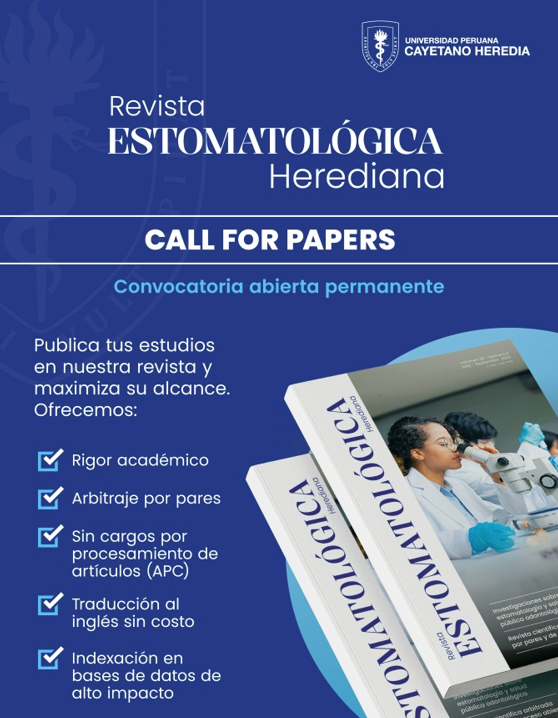Evaluación del tiempo de exposición de una resina Bulk-Fill en preparaciones profundas
DOI:
https://doi.org/10.20453/reh.v32i1.4180Palabras clave:
Dureza, tiempo, resinas compuestas, polimerizaciónResumen
Antecedentes: Las resinas compuestas tipo Bulk-Fill (BF) son usadas en piezas posteriores con preparaciones extensas y profundas. Uno de sus beneficios más resaltantes es que, puede ser utilizada en incrementos de 4 a 5 mm, disminuyendo el tiempo de trabajo clínico. Sin embargo, en dientes con tratamientos de conductos estas preparaciones podrían tener mayor profundidad. Objetivos: Determinar el tiempo de fotoactivación necesario para polimerizar una resina Bulk-Fill ubicada en zonas profundas. Material y Métodos: En el presente estudio experimental in vitro, se confeccionaron especímenes de resina compuesta Filtek One Bulk Fill (3M ESPE, St. Paul, EE.UU.) de 5x5x5 mm color A2 fotoactivado a una distancia/tiempo de 0 mm/10 s, 0 mm/20 s, 3 mm/10 s, 3 mm/20 s, 3 mm/30 s y 3 mm/40 s (n=5). La microdureza superficial se registró en la superficie y en la base de cada espécimen. Resultados: El mayor valor de microdureza se registró en el grupo BF 0 mm/20 s y BF 3 mm/40 s (p<0,05), seguido por los grupos BF 3 mm/20 s y BF 3 mm/30 s (p>0,05). Los menores valores de microdureza se encontraron en los grupos BF 0 mm/10 s y BF 3 mm/10 s. Conclusión: Se requiere de 40 s de fotoactivación para polimerizar una resina Bulk-Fill ubicada en zonas profundas, cuando la lámpara está a una distancia de 3 mm de la superficie de la resina.
Descargas
Citas
Del Valle Rodríguez A,Christiani J, Álvarez N, Zamudio M. Revisión de resinas Bulk Fill: Estado actual. Rev Ateneo Argent Odontol. 2018; 58(1):55-60.
Kim RJ, Son SA, Hwang JY, Lee IB, Seo DG. Comparison of photopolymerization temperature increases in internal and external positions of composite and tooth cavities in real time: Incremental fillings of microhybrid composite vs. bulk filling of bulk fill composite. J. Dent. 2015;43(1):1093-1098.
Elshazly T, Bourauel C, Aboushelib M, Sherief D, El- Korashy D. The polymerization efficiency of a bulk- fill composite based on matrix-modification technology. Restor Dent Endod. 2020;45(3):1-12.
Yarmohammadi E, Kasraei Sh, Sadeghi Y. Comparative Assessment of Cuspal Deflection in Premolars Restored with Bulk-Fill and Conventional Composite Resins. Front Dent. 2019;16(6):407-414.
Almuallem L, McDonnell S, Bussuttil-Naudi A, Santini A. The effect of irradiation distance on light transmittance and vickers hardness ratio of two Bulk- fill resin-based composites. Eur J of Prosthodont Restor Dent. 2016; 24(4):203-214.
Tsuzuki FM, de Castro-Hoshino LV, Lopes LC, Sato F, Baesso ML, Terada RS. Evaluation of the influence of light-curing units on the degree of conversion in depth of a bulk-fill resin. J Clin Exp Dent. 2020;12(12):1117- 1123.
Ilie N, Luca B. Efficacy of modern light curing units in polymerizing peripheral zones in simulated large Bulk- fill Resin-composite Fillings. Oper Dent. 2018; 43(4):416-425.
Colombo M, Gallo S, Poggio C, Ricaldone V, Arciola C, Scribante A. New Resin-Based Bulk-Fill Composites: in vitro Evaluation of Micro-Hardness and Depth of Cure as Infection Risk Indexes. Mater. 2020;13(6):1-13.
Ide k, Nakajima M, Hayashi J, et al. Effect of light- curing time on light-cure/post-cure volumetric polymerization shrinkage and regional ultimate tensile strength at different depths of bulk-fill resin composites. Dent Mater J. 2019;38(4):621-629.
Alkhudhairy F. The effects of irradiance and exposure time on the surface roughness of bulk-fill composite resin restorative materials. Saudi Med J.2018;39(2):197- 202. .
Leprince, J, Palin, W, Hadis, M, Devaux J, Leloup G. Progress in dimethacrylate-based dental composite technology and curing efficiency. Dent Mater.2013; 29(2):139-156.
Tarle Z, Attin T, Marovic D, Andermatt L, Ristic M, Tauböck T. Influence of irradiation time on subsurface degree of conversion and microhardness of high- viscosity bulk-fill resin composites. Clin Oral Invest. 2014;19(4):831-840.
Voltarelli FR, Dos Santos-Daroz CB, Alves MC, Peris AR, Marchi GM. Effectiveness of resin composite polymerization when cured at different depths and with different curing lights. Gen Dent. 2009;57(4):314-319.
Shimokawa C, Turbino M, Giannini M, Braga R, Price R. Effect of Curing Light and Exposure Time on the Polymerization of Bulk-Fill Resin-Based Composites in MolarTeeth.Oper Dent..2020;45(3):141- 155.
Par M, Repusic I, Skenderovic H, Sever E.K, Marovic D, Tarle Z. Real-time Light Transmittance Monitoring for Determining Polymerization Completeness of Conventional and Bulk Fill Dental Composites. Oper Dent. 2018; 43(1):19-31.
Al-Zain AO, Platt JA. Effect of light-curing distance and curing time on composite microflexural strength. Dent Mater J. 2021;40(1):202-208.
Galvão MR, Caldas SGFR, Bagnato VS, De Souza Rastelli AN, De Andrade MF. Evaluation of Degree of Conversion and Hardness of Dental Composites Photo- Activated with Different Light Guide Tips. Eur J Dent. 2013;7(1):86-93.
Comba A, Scotti N, Maravić T, et al. Vickers Hardness and Shrinkage Stress Evaluation of Low and High Viscosity Bulk-Fill Resin Composite. Polymers (Basel). 2020;12(7):14-77
Descargas
Publicado
Cómo citar
Número
Sección
Licencia
Los autores conservan los derechos de autor y ceden a la revista el derecho de primera publicación, con el trabajo registrado con la Licencia de Creative Commons, que permite a terceros utilizar lo publicado siempre que mencionen la autoría del trabajo, y a la primera publicación en esta revista.























